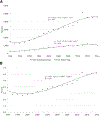Assisted reproductive technology with donor sperm: national trends and perinatal outcomes
- PMID: 29291411
- PMCID: PMC11056969
- DOI: 10.1016/j.ajog.2017.12.224
Assisted reproductive technology with donor sperm: national trends and perinatal outcomes
Abstract
Background: Information regarding the use of donor sperm in assisted reproductive technology, as well as subsequent treatment and perinatal outcomes, remains limited. Outcome data would aid patient counseling and clinical decision making.
Objectives: The objectives of the study were to report national trends in donor sperm utilization and live birth rates of donor sperm-assisted reproductive technology cycles in the United States and to compare assisted reproductive technology treatment and perinatal outcomes between cycles using donor and nondonor sperm. We hypothesize these outcomes to be comparable between donor and nondonor sperm cycles.
Study design: This was a retrospective cohort study using data from all US fertility centers reporting to the Centers for Disease Control and Prevention's National Assisted Reproductive Technology Surveillance System, accounting for ∼98% of assisted reproductive technology cycles (definition excludes intrauterine insemination). The number and percentage of assisted reproductive technology cycles using donor sperm and rates of pregnancy, live birth, preterm birth (<37 weeks), and low birthweight (<2500 g) were the primary outcomes measured. Treatments assessed include use of donor vs nondonor sperm. The trends analysis included all banking and fresh assisted reproductive technology cycles using donor and autologous oocytes performed between 1996 and 2014 (n = 1,710,034). The outcomes analysis was restricted to include only fresh autologous cycles performed between 2010 and 2014 (n = 437,569) to focus on cycles with a potential outcome and cycles reflective of current practice, thereby improving the clinical relevance. Cycles canceled prior to retrieval were excluded. Statistical analysis included linear regression to explore polynomial trends and log-binomial regression to estimate relative risk for outcomes among cycles using donor and nondonor sperm.
Results: Of all banking and fresh donor and autologous oocyte assisted reproductive technology cycles performed between 1996 and 2014, 74,892 (4.4%) used donor sperm. In 2014, 7351 assisted reproductive technology cycles using donor sperm were performed, as compared with 1763 in 1996 (6.2% vs 3.8% of all cycles). Among all autologous oocyte cycles performed between 2010 and 2014, the live birth rate was lower for donor sperm (27.9%) than nondonor sperm cycles (32.5%); however, after adjustment for maternal age, donor sperm use was associated with an increased likelihood of live birth (adjusted relative risk, 1.06, 95% confidence interval, 1.01-1.10). Per transfer, there was no significant difference in live birth rates for donor vs nondonor sperm (31.9% vs 36.8%; adjusted relative risk, 1.04, 95% confidence interval, 0.998-1.09). Per singleton live birth, there was no significant difference in preterm birth (11.5% vs 11.8%; adjusted relative risk, 0.98, 95% confidence interval, 0.90-1.06); however, low birthweight delivery was slightly lower in donor sperm cycles (8.8% vs 9.4%; adjusted relative risk, 0.91, 95% confidence interval, 0.83-0.99).
Conclusion: Donor sperm use in assisted reproductive technology has increased in the United States, accounting for approximately 6% of all assisted reproductive technology cycles in 2014. Assisted reproductive technology treatment and perinatal outcomes were clinically similar in donor and nondonor sperm cycles.
Keywords: donor sperm; in vitro fertilization; perinatal outcomes; third party reproduction.
Copyright © 2018 Elsevier Inc. All rights reserved.
Conflict of interest statement
The authors report no conflict of interest.
Figures



References
-
- Gregoire AT, Mayer RC. The impregnators. (William Pancoast) (Addison Davis Hard). Fertil Steril 1965;16:130–4. - PubMed
-
- Steinberger E, Smith KD. Artificial insemination with fresh or frozen semen. A comparative study. JAMA 1973;223:778–83. - PubMed
-
- Kushnir VA, Darmon SK, Shapiro AJ, Albertini DF, Barad DH, Gleicher N. Utilization of third-party in vitro fertilization in the United States. Am J Obstet Gynecol 2017;216:266. e1–10. - PubMed
-
- HFaE. Egg and sperm donation in the UK. 2012–2013. Available at: https://ifqlive.blob.core.windows.net/umbraco-website/2026/egg-and-sperm.... Accessed Nov. 16, 2017.
MeSH terms
Grants and funding
LinkOut - more resources
Full Text Sources
Other Literature Sources
Medical

